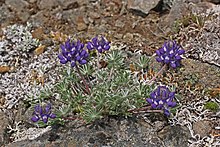Lupinus lepidus
| Lupinus lepidus | |
|---|---|

| |
| Lupinus lepidus var. lobbii (prairie lupine) | |
| Scientific classification | |
| Kingdom: | Plantae |
| Clade: | Tracheophytes |
| Clade: | Angiosperms |
| Clade: | Eudicots |
| Clade: | Rosids |
| Order: | Fabales |
| Family: | Fabaceae |
| Subfamily: | Faboideae |
| Genus: | Lupinus |
| Species: | L. lepidus
|
| Binomial name | |
| Lupinus lepidus | |
Lupinus lepidus, the Pacific lupine,[2] prairie lupine or dwarf lupine is a perennial herbaceous plant in the pea family (Fabaceae) native to western North America.
Description
[edit]
Lupinus lepidus is a small hairy perennial that reaches 10 to 61 centimetres (4 to 24 inches).[3] Palmately compound leaves extend up the stem, but most are basal.[3] The inflorescence is a dense spike-like raceme, with pink, purple, or blue flowers that often have a yellowish spot.[3] The plant blooms from mid-April through August, depending on elevation and habitat.[4] The fruit is a pod containing multiple seeds.[3]
Taxonomy
[edit]Many varieties have been described, several of which are considered separate species by some authorities.[5]
Distribution and habitat
[edit]The species is endemic to western North America,[6] where it may be found in open areas from low prairie, open montane forest, to the alpine. Although rare in British Columbia, its range extends south from Alaska to southern California and eastward to the Rocky Mountains.[7][4][5] In California, it is mainly a species of meadows and areas that are moist during the spring growing season in the Sierra Nevada mountain range, from 1,500 to 3,000 metres (4,900 to 9,800 ft).[3]
References
[edit]- ^ "Lupinus lepidus Lindl". GBIF.org. Retrieved 7 August 2014.
- ^ USDA, NRCS (n.d.). "Lupinus lepidus". The PLANTS Database (plants.usda.gov). Greensboro, North Carolina: National Plant Data Team. Retrieved 24 June 2015.
- ^ a b c d e Sierra Nevada Wildflowers, Karen Wiese, 2nd Ed., 2013, p. 35
- ^ a b Sullivan, Steven. K. (2015). "Lupinus lepidus". Wildflower Search. Retrieved 2015-01-17.
- ^ a b "Lupinus lepidus". PLANTS Database. United States Department of Agriculture; Natural Resources Conservation Service. 2015. Retrieved 2015-01-17.
- ^ Giblin, David, ed. (2015). "Lupinus lepidus". WTU Herbarium Image Collection. Burke Museum, University of Washington. Retrieved 2015-01-17.
- ^ Klinkenberg, Brian, ed. (2014). "Lupinus lepidus". E-Flora BC: Electronic Atlas of the Plants of British Columbia [eflora.bc.ca]. Lab for Advanced Spatial Analysis, Department of Geography, University of British Columbia, Vancouver. Retrieved 2015-01-17.
External links
[edit] Media related to Lupinus lepidus at Wikimedia Commons
Media related to Lupinus lepidus at Wikimedia Commons Data related to Lupinus lepidus at Wikispecies
Data related to Lupinus lepidus at Wikispecies
